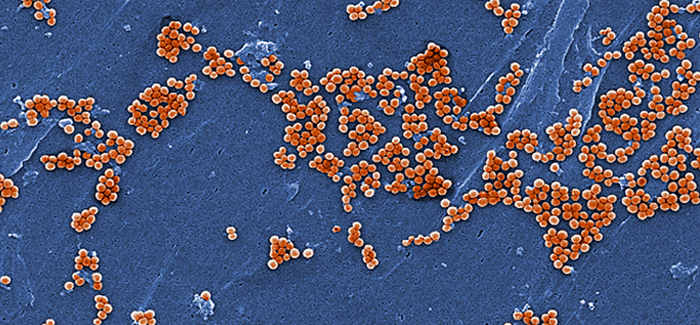
S. aureus turns the immune system against itself. (CDC/Jeff Hageman, M.H.S./Janice Haney Carr)
A bacterium pits the immune system against itself, the divergent genetics of assocated diseases, labor’s shrinking piece of the pie, and how place influences transgender acceptance.
Divide and conquer
The Staphylococcus aureus bacterium irritates on scales both small and large, causing everything from boils to potentially fatal MRSA. The secret to its success, UChicago microbiologists Olaf Schneewind, Vilasack Thammavongsa, and Dominique Missiakas discovered, is the way S. aureus pits the immune system against itself. Isolating two mutations of the bacteria that rendered them unable to survive attack by macrophages, a type of white blood cell, the researchers added neutrophil extracellular traps (NETs), networks of fibers produced by white blood cells that capture invaders into the immune system. The researchers found that S. aureus fought off the attack by converting NETs into molecules toxic to macrophages. Their study was published November 15 in Science.
Disordered differently
Obsessive-compulsive disorder and Tourette’s syndrome are often associated, but new genetic analysis in the October PLOS Genetics reveals that the illnesses are passed from generation to generation in very different ways. Following up on two 2012 studies, a research team of dozens, including UChicago geneticist Nancy J. Cox and postdocs Patrick Evans, PhD’07, and Lea K. Davis, searched for genetic variations associated with each disease. Comparing variations simultaneously across the entire genome, they found that 21 percent of genetic risk for Tourette’s comes from rare variants, while susceptibility to OCD arose solely from common variants. The research team calculated Tourette’s to be more heritable than OCD, at 58 percent compared to 37 percent, confirming previous results from studies on twins and families.
Labor forced out
Since the 1980s, labor has constituted a smaller and smaller part of the global economy, according to a June working paper by Chicago Booth economists Loukas Karabarbounis and Brent Neiman for the National Bureau of Economic Research. Analyzing 59 countries, they found that workers’ share of GDP has declined by about five percentage points, and that this pattern holds in the world’s four largest economies—the United States, Japan, China, and Germany—and in a majority of industries. By way of explanation, Karabarbounis and Neiman compared trends in labor share and price of investment in national economies and found that the two go hand in hand. Roughly half of the decline in labor, they calculate, can be attributed to lower prices for investment goods like machinery and other technology, inducing companies to shift away from live workers.
Gender panic
For the past several decades Americans have generally supported autonomy and equality when it comes to which gender people identify as. But acceptance of transgender people often hinges on the question of place, says UChicago sociologist Kristen Schilt. In the October Gender and Society, Schilt and coauthor Laurel Westbrook examined the concept of “gender panic,” a deep cultural fear sometimes set off when the “naturalness” of the male-female binary divide is challenged. In “non-sexual” spaces like the workplace, transgender people generally find acceptance, regardless of whether their genitalia match the gender identity they claim. But in women-only spaces, such as women’s bathrooms, that acceptance ends. Asserting a gender identity is insufficient; to be accepted, it must be accompanied by anatomical change. “We found that what calms down the panic is having a very clear policy about who’s in your bathroom, and that policy relates very distinctly to genitalia,” Schilt says. The same panic rarely applies to men-only spaces. Schilt and Westbrook attributed that difference to deep-seated social beliefs about the vulnerability of women compared to men.
